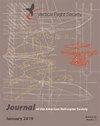Performance and Loads of a Wing-Offset Compound Helicopter
IF 1.4
4区 工程技术
Q2 ENGINEERING, AEROSPACE
引用次数: 0
Abstract
Analysis of a hingeless rotor with a single wing on the retreating side for lift compounding was conducted. The goals included validation of performance and load predictions with wind tunnel test data, study of the impact of different aerodynamic inflow models, and understanding of benefits by lift compounding with a single wing on the retreating side. The three primary test cases include collective sweeps of the isolated rotor, and the rotor with the wing, at two different incidence angles. The comprehensive analysis was able to accurately predict the performance and blade structural loads of both the isolated rotor and rotor plus wing configurations. Overprediction of propulsive force leads to underprediction of lift-to-drag ratio in several cases. The normal bending moments were well captured for all cases, while the chord bending moment predictions had a phase offset from the test data, but magnitude and harmonics were captured. Comparing inflow models found that dynamic inflow and vortex wake (prescribed and free) models provided similar results. At these advance ratios, prescribed and free wake models showed almost no differences. Additionally, the vortex particle method showed an overprediction of thrust and greater rotorto-wing aerodynamic interference compared to test data. The addition of the wing on the retreating side provided dual benefits of increasing maximum lift-to-drag ratio and reduction of structural loads for a given total thrust. These effects are a result of both lift share between the rotor and wing, and lift offset, the rotor carries a roll moment to balance the wing's roll moment.机翼偏置复合直升机的性能和载荷
对一种后撤侧单翼无铰转子进行了升力复合分析。目标包括利用风洞试验数据验证性能和载荷预测,研究不同气动流入模型的影响,以及了解在后退侧采用单翼复合升力的好处。三个主要测试用例包括隔离转子和带翼转子在两种不同入射角下的集体扫掠。综合分析能够准确预测转子隔离和转子加翼两种构型的性能和叶片结构载荷。在某些情况下,对推进力的过度预测会导致升阻比的低估。所有情况下的正常弯矩都被很好地捕获,而和弦弯矩预测与测试数据有相位偏移,但幅度和谐波被捕获。对比入流模型发现动态入流模型和旋涡尾迹模型(规定模型和自由模型)的结果相似。在这些超前比下,规定尾流模型和自由尾流模型几乎没有差异。此外,与测试数据相比,涡旋粒子法对推力的预测过高,旋翼气动干扰更大。在后退侧增加机翼提供了双重好处,增加了最大升阻比,并减少了给定总推力下的结构负载。这些影响是由于转子和机翼之间的升力份额和升力抵消,转子携带一个滚转力矩来平衡机翼的滚转力矩。
本文章由计算机程序翻译,如有差异,请以英文原文为准。
求助全文
约1分钟内获得全文
求助全文
来源期刊

Journal of the American Helicopter Society
工程技术-工程:宇航
CiteScore
4.10
自引率
33.30%
发文量
36
审稿时长
>12 weeks
期刊介绍:
The Journal of the American Helicopter Society is a peer-reviewed technical journal published quarterly (January, April, July and October) by AHS — The Vertical Flight Society. It is the world''s only scientific journal dedicated to vertical flight technology and is available in print and online.
The Journal publishes original technical papers dealing with theory and practice of vertical flight. The Journal seeks to foster the exchange of significant new ideas and information about helicopters and V/STOL aircraft. The scope of the Journal covers the full range of research, analysis, design, manufacturing, test, operations, and support. A constantly growing list of specialty areas is included within that scope. These range from the classical specialties like aerodynamic, dynamics and structures to more recent priorities such as acoustics, materials and signature reduction and to operational issues such as design criteria, safety and reliability. (Note: semi- and nontechnical articles of more general interest reporting current events or experiences should be sent to the VFS magazine
 求助内容:
求助内容: 应助结果提醒方式:
应助结果提醒方式:


